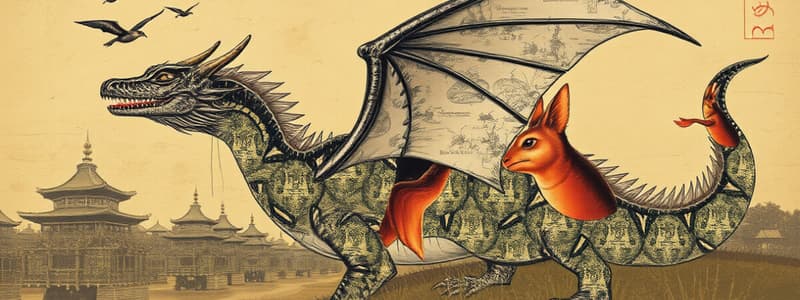Podcast
Questions and Answers
What is the primary reason that Komodo dragons prefer to scavenge carrion rather than hunt live prey?
What is the primary reason that Komodo dragons prefer to scavenge carrion rather than hunt live prey?
- They have a specific diet that requires carrion.
- They are naturally lazy and prefer to conserve energy. (correct)
- They are not fast enough to catch live prey.
- Their venom makes hunting too dangerous.
How do Komodo dragons deliver venom to their prey?
How do Komodo dragons deliver venom to their prey?
- By rubbing it on the ground before hunting.
- By injecting venom through their claws.
- By breathing it into their prey's wounds.
- Through their saliva while biting. (correct)
What is a significant drawback of parthenogenesis in Komodo dragons?
What is a significant drawback of parthenogenesis in Komodo dragons?
- It increases the number of females significantly.
- It always results in male offspring. (correct)
- It leads to a diverse gene pool.
- It allows for faster reproduction rates.
What unique reproductive method do Komodo dragons share with a few other lizard species?
What unique reproductive method do Komodo dragons share with a few other lizard species?
Which of the following statements about Komodo dragons is true?
Which of the following statements about Komodo dragons is true?
What threat significantly impacts the habitat of Komodo dragons?
What threat significantly impacts the habitat of Komodo dragons?
What type of habitat do Komodo dragons primarily inhabit?
What type of habitat do Komodo dragons primarily inhabit?
Why was the national park on Komodo Island established?
Why was the national park on Komodo Island established?
What is a consequence of many related males and females in a species?
What is a consequence of many related males and females in a species?
What does the term 'carnivore' imply about Komodo dragons?
What does the term 'carnivore' imply about Komodo dragons?
Flashcards are hidden until you start studying
Study Notes
Dragons in Myth and Reality
- Dragons have been prominent in myths since Ancient Greece, often depicted in fantasy literature and films.
- The Komodo dragon is a real reptile, native to the Sunda Islands of Indonesia, weighing over 300 pounds and measuring nearly 10 feet in length.
Adaptations and Habitat
- Komodo dragons inhabit harsh, rocky environments in tropical regions with lower rainfall compared to other parts of Indonesia.
- The average temperature on Komodo Island can reach 30°C, even in the cooler months of July and August.
Behavior and Diet
- Despite being capable of running at speeds up to 12 mph, Komodo dragons prefer a more sedentary lifestyle, often scavenging carrion rather than hunting live prey.
- They typically remain close to their home territory and wait along pathways for animals to pass, striking when opportunities arise.
Unique Feeding Mechanism
- The bite of a Komodo dragon is lethal due to venom that prevents blood clotting, leading to shock in the victim.
- Prey often suffers fatal injuries from the bite, allowing the dragon to track its meal until it succumbs.
Reproduction Strategies
- Komodo dragons can reproduce through parthenogenesis, allowing females to breed without males present.
- This process results in male offspring, contributing to a genetically bottlenecked population and increasing vulnerability to mutations.
Conservation Challenges
- Human activities such as deforestation, land burning, and poaching threaten the Komodo dragons' habitat and survival.
- To combat these threats, the Indonesian government established a national park on Komodo Island in 1980, which serves both conservation and tourism purposes.
Vocabulary Notes
- "Plod" suggests a heavy, slow movement, characterizing the dragon's locomotion.
- "Hence" indicates a logical connection or cause, relating to the name Komodo Island.
- "Carnivore" designates Komodo dragons as meat-eaters, reflecting their predatory nature.
Studying That Suits You
Use AI to generate personalized quizzes and flashcards to suit your learning preferences.




